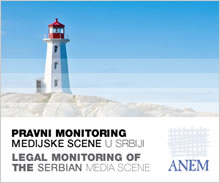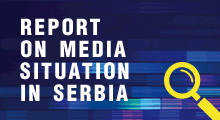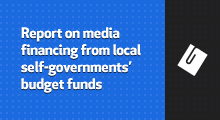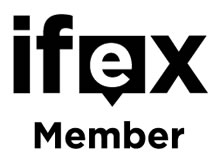Home
/
Media Scene
/
Region and world
04. 05. 2005
MISSION (IM)POSSIBLE
However, new media were established – first the fortnightly magazine “Krug”, then the weekly “Monitor”... They were the first private media in Montenegro , the first outlets independent and free of state or party influence. At that time, independent media were established as a kind of cultural and political opposition to the ruling, state ideology of the Montenegrin political elite, which – in collaboration with the policy of Milosevic's Belgrade – was propagating war with neighbors and national hatred. By the middle of 1994, the first private radio in Montenegro - radio “Antena M”, started working, and in 1997, the first private TV - “Blue Moon”. Political Conflict Results in a Media Deluge During 1997, the media in Montenegro literally flourished in numbers. That was a time when a part of the Montenegrin ruling party spearheaded by Milo Djukanovic opposed Milosevic's policy. There was enormous pressure coming from Belgrade upon the Montenegrin authorities and they fully supported the development of private media, wishing to provide democratic support for their policy. At that time, the international community was also heavily supporting the independent Montenegrin media. This was done not solely to develop democratic society in Montenegro , but also as a means of fighting the dictatorship in Serbia . Thanks to the existence of a common market, media registered in Montenegro could be sold in Serbia without any restrictions. In September 1997, out of the weekly “Monitor” the first private daily newspaper was founded in Montenegro - the daily “Vijesti”. This was definitely the beginning of a new era. The daily ‘Vijesti” was the first to succeed in combining professional and marketing principles. This media outlet, in addition to assistance from abroad, also managed to secure substantial revenue from domestic sources. At that time, even some Serbian media, fleeing from Milosevic, had registered in Podgorica (“Dnevni Telegraf” and “Danas”). In the same period (1997-2000), the biggest inflow of foreign donations in the media sector was reported – approximately 500,000 euros annually. On the other hand, the regime in Belgrade responded. Milosevic initiated logistical help in order to establish “his” media in Montenegro . Thus, in 1998 the daily “Dan” was founded as the second private newspaper in Montenegro after the independent daily “Vijesti”. Besides “Dan”, official Belgrade - through financial help of the Federal Government - helped found the radio station “Radio D”, “TV YU Info”, as well as some other media, which served as mouthpieces of Milosevic's policy in Montenegro. The political struggle – between Milosevic's opponents and Milosevic's supporters in Montenegro –significantly contributed to development of numerous media outlets on the Montenegrin scene. This has affected even the present media market in Montenegro ; by inertia – it still has too many media. According to a Montenegrin Media Institute report, there are four registered dailies, three weeklies, and 17 periodical newspapers in Montenegro . The “crowd” is even greater with regard to electronic media: 15 TV stations and 43 radio stations, including local public TV and radio services. In all, there are 108 registered media outlets and seven registered media bureaus in Montenegro , which employ 1,904 professionals (1,170 full-time employees and 734 part-time). These numbers illustrate a problem facing the media in the Montenegrin skies: for a state with a mere population of 670,000 – the media offer is too big. Furthermore, Montenegro is not a particularly interesting location, politically or economically, for development of media and outside investment. Therefore, during 2002, 2003, and especially during 2004, a reduced inflow of foreign donations into Montenegrin media was particularly evident. Foreign analysts obviously concluded that the worst period was behind us and that the media must provide their own sustainability. According to all indicators, foreign donations or credits for Montenegrin media in 2005 will not exceed 150,000 euros. How will the Montenegrin media, and which media outlets specifically, survive the time to come? State electronic media: challenges of public service Almost all formal and legal conditions for transformation of state TV and radio into a public service have been met. At the end of 2003, the Public Service Act was adopted, and in line with the act, next year, in 2004, a new management structure was elected: Steering Board and Programming Council of Montenegrin Radio and Television (RTVCG). The Director and Programming Director of RTVCG were also elected. All this was done in line with international standards and recommendations of OSCE experts. Despite all this, transformation of RTVCG is doubtful and we can hardly speak of any kind of significant development. The main culprit is - the state, i.e. the ruling structures. Instead of helping the metamorphosis of state TV and radio into a public service, the Montenegrin state has brought the RTVCG to the brink of survival by reducing funds from the budget and by irregular inflow of funds coming from TV subscription. In mid-June 2004, the Montenegrin Constitutional Court ruled that the model of collection of RTV subscription fee through telephone bills is unconstitutional. The Court concluded that by charging broadcasting subscription fee together with telephone bills – without checking whether a particular individual or company has a radio or TV receiver - all those who pay telephone bills, but do not possess a radio or TV receiver, are placed in an unequal position. Thus, the recommendation (order) of the Constitutional Court is to collect broadcasting subscription fee only from those who are unquestionably determined to possess a radio or TV. The Constitutional Court decision will bring additional financial trouble to the management of Montenegrin RTV. Even the current subscription collection mechanism is unreliable. The Broadcasting Agency, during 2004, paid a little more than 50 percent of the total funds that were supposed to come from radio and TV subscription fee. As subscription was collected directly through telephone bills, it is obvious that the state run company (Montenegrin Telecom) was unfairly delaying the payments. It is interesting that the state prosecutor has not initiated any investigation on whether somebody had illegally redistributed the RTV subscription money and used it for some other purpose. The described example is just one of many state obstructions in the financial area. How the Government views the state broadcasters is illustrated by the example of reduction of the Government budget. Namely, within the Montenegrin Government budget for the previous year 2004, 2,600,000 euros was planned for financing the Montenegrin RTV public service. In the middle of the same year, when the Government of Montenegro decided to reduce budget expenditures, the public service was the first casualty. Instead of the planned 2,600,000 euros, the Montenegrin Government gave Montenegrin RTV - one million euros less! This clearly illustrates the real level of interest of the state leadership in fast and efficient transformation of the state media into a public service. This is just the financial part of the problem facing the management team of RTVCG. Earlier debts amount to 6.5 million euros, and RTVCG employs as many as 1,004 employees (according to the pay-list from December 2004). With these kinds of burdens, the survival of state electronic media is really questionable. The RTVCG Statute foresees eight ways, mechanisms, and sources of financing for this company: 1) TV subscription fee, 2) tax on car radios, 3) production and broadcasting of advertisements, 4) production and sale of audiovisual works, 5) sponsorship of programming contents, 6) organizing concerts, 7) funds from the state budget, and 8) other sources of financing. Formally, there are a variety of revenue sources for financing RTVCG. However, in reality, the amount from subscription fee represents as much as 80 percent of the total required funds. As the Constitutional Court has contested the method of subscription fee collection and the state has reduced budget expenditures for the public service - the survival of RTVCG is endangered. What follows is a direct struggle for survival. The RTVCG management team has already announced that by the end of April 2005, it will dismiss 120 employees (more than 10% of the total number) in order to reduce current expenditures. However, this is just one possible way of cutting costs, and in the months that lie ahead RTVCG is yet to secure its survival. Private print media: small swamp full of crocodiles Although the position of state electronic media is very difficult, the media that are not under the control or that do not enjoy the support either of the state or of some party are in the most difficult position of all. On the small Montenegrin market, in a country facing bankruptcy, the media can hardly expect to make a living just off sales and marketing. Surveys of the media sector point to a need for drastic changes in order for some media to survive in this new situation. Montenegrin print media have become, in the past fifteen years, an inevitable and very influential factor in shaping public opinion. As already said, currently there are four dailies in Montenegro (“Pobjeda”, “Vijesti”, “Dan” and “Republika”), thee weeklies (“Monitor”, “Revija D” and “Koha Javore”) and 17 periodicals. Besides “Pobjeda” and the weekly “Koha Javore”, which are state companies, all other media houses were founded with private capital and are owned by private businessmen. True, the state did take part in the establishment of the daily “Dan”, but from the level of FRY: the daily received, as a “gift”, printing machines and printing paper from the Federal Government, whose prime minister, at the time, was Momir Bulatovic. According to Montenegrin media reports, the total investment in the daily “Dan” was 1,700,000 German marks (approximately 800,000 euros). Nevertheless, the daily “Dan” was registered at the Commercial Court as a private media company with known owners. According to surveys carried out by numerous agencies, the most read daily on the Montenegrin market is “Vijesti”, followed by “Dan”, then “Pobjeda”, and finally “Republika”. Serbian daily newspapers, although regularly present on the Montenegrin market, cannot compete with Montenegrin editions. The fates and operating methods of the Montenegrin dailies differ. The most read daily newspaper in Montenegro , the independent daily “Vijesti” (its average circulation in 2002 and 2003 was around 20,000 copies), was the first that turned to new goals: looking for a strategic partner. The company management, which had been doing business successfully since its appearance in 1997, assessed that it must innovate, not just the newspaper, but the printing department as well. Besides, they wanted to be prepared for the imminent inflow of foreign capital – by finding a foreign buyer for their stock. “We didn't have any survival problems. Although we have more than 130 employees, thanks to the high circulation of some 20,000 copies a day, and substantial revenue from advertising, our daily had a guaranteed place on the Montenegrin market”, says Zeljko Ivanovic, Director of “Vijesti”. At the beginning of 2003, the independent daily “Vijesti” started negotiations with the German concern WAZ (Western Algemeine Zeitung). The German media magnate had already positioned itself in the Balkans, first through investments in Croatia and Macedonia , and later also in Serbia , where it bought 50 percent of stock in the daily newspaper “Politika”. WAZ entered Montenegro through investments in the daily “Vijesti”: it bought 50 percent of the printing firm “Roto slog” (owned by the daily “Vijesti” and weekly “Monitor”) and simultaneously 50 percent of the “Vijesti” stock. “The editorial policy – as regulated by the sale contract – has remained completely in the hands of the ‘Vijesti' editorial team. WAZ will put effort into improving management, distribution and debt collection. Thus, we have retained our independence and at the same time found a strategic partner willing to invest in our company”, says the Director of “Vijesti”, Ivanovic. How much the German concern has paid for 50 percent of stock in the most popular Montenegrin daily remains confidential between “Vijesti” and “WAZ”. In the book “Media ownership and its influence on independence and pluralism of media”, published by the Montenegrin Media Institute, it says that “WAZ bought 50 percent of the paper's stock for approximately five million euros”. It is no secret that WAZ is ready to invest heavily in Montenegro . In the middle of last year, the German concern introduced a new printing press in Montenegro , worth almost two million euros. After necessary preparations, it is estimated that the printing press will be operational at the beginning of the summer of 2005. No doubt, the printing press will be able to print dailies and magazines in color, and in technical terms, it will be far ahead of the competition in Montenegro . By the way, this investment of WAZ will be the biggest investment of foreign capital in the Montenegrin media sector in 2005, but also one of the most significant investments in Montenegrin economy as a whole. Why did the big German player decide to invest this much in Montenegro ? Equipped with the most advanced printing press in Montenegro , “WAZ” can take the final step in conquering the media: no one will be able to match the prices of its printing products and experts assess that the new printing department will take over the printing of the majority of print editions in Montenegro . Under the assumption that WAZ will manage to centralize the press, i.e. take over the printing of other dailies and magazines, it will need seven years to return the capital invested in buying 50 percent of “Vijesti” stock and acquiring the new printing machine. After that period, all earnings will represent – extra profit. Financial power is naturally accompanied by political power. By controlling the relevant media in Montenegro , the German concern could - indirectly, using the media under its control - influence political events in Montenegro . Nevertheless, it is obvious that this new position, after the entrance of German capital, offers the editorial team and journalists of “Vijesti” a very comfortable position. In the meantime, the management team of “Vijesti”, independently of “WAZ”, managed to carry out some activities which led to a significant increase in revenue and rise in circulation. One of these activities was the campaign “Books are fashionable”; “Vijesti” – the first in the Balkans - started a campaign of selling very valuable books together with the newspaper. In cooperation with a Spanish company, “Mediaset”, “Vijesti” sold a valuable book once a week (usually bestsellers by foreign and domestic authors) together with a copy of “Vijesti” for the price of just 2.99 euros. Since the average price of these books is around 13 euros, the campaign was an incredible success: every Thursday, on average some 25,000 books were sold, and at the very beginning as many as 30,000(!). At the end of 2004, “Vijesti” launched an action sale of CDs of domestic production and this campaign was also a success (around 9,000 CDs weekly). This has significantly relaxed the financial operations of “Vijesti” and turned this media house into a very successful Montenegrin company. How do other private and independent print media survive? Unlike “Vijesti”, other print media have less reason for optimism. The daily “Pobjeda”, once financed directly from the budget, is now adjusting to self-financing. To be honest, “Pobjeda” has very good printing machinery, which means a good basis for successful business. Many years spent on the state budget and a large number of employees (estimates are some 300 surplus employees) have made the position of this daily very difficult. The already mentioned “Dan” was initially closely linked to the Socialist People's Party (SNP), founded by the former prime minister of the Federal Republic of Yugoslavia (FRY), Momir Bulatovic. However, step-by-step, “Dan” broke free of party influence and today – although still publishing articles spreading hate speech - it is not under the patronage of any political party. One can rather say that the daily “Dan” is the voice of the political option in favor of a common state, but it is not attached to any party or coalition. The fact remains that with the current circulation, “Dan” is barely making ends meets. Although we are talking about a high circulation of 15,000 - 16,000 copies (official data is impossible to obtain), this is enough for bare survival, and according to independent estimates it covers only 60 percent of expenditures. The problem is that “Dan” - trying to overcome the competition - started charging almost dumping prices for advertising space. However, this has not resulted in a desired turn: a somewhat increased number of advertisements was insufficient for economic growth. The youngest Montenegrin daily - “Republika” from Podgorica - is in the most difficult position of all. The daily continues in the footsteps of the also financially unsuccessful “Publika”. This new project and cooperation with a Russian partner have not produced the expected results. The circulation does not exceed 2,000, so “Republika” has almost no chances of survival, but it is still operating thanks to the founder's investments. The real question is: “what is the interest of the Russian partner to finance an unsuccessful media project?” Although the total circulation of all dailies in Montenegro is unusually high – it is estimated that Montenegrin dailies are bought on average by 60,000 readers (almost 10 percent of the total population) – all current dailies simply will not endure the competition. In the meantime, Montenegrin weeklies are living perhaps their worst days. In 1990, when Monitor” was founded, it looked as if Montenegrin weeklies would survive more easily than dailies. At the beginning, thanks to foreign donations and political party interests, we had five weeklies in Montenegro . Nevertheless, in the last three years “Onogost” and “Kronika”, as well as the party newspaper “Liberal” (later called “Montenegro Tribune”) were closed down. The position of the other weeklies is not splendid either. To be more precise, of the classical weeklies (newsmagazines), only the oldest one is still standing – the independent weekly “Monitor”, which is celebrating 15 years of work this year. The other two editions are not real magazines. “Revija D” is a mixture between a tabloid and yellow journalism, while “Koha Javore” is a weekly in the Albanian language financed exclusively from the budget. “The Montenegrin independent weekly Monitor is at the crossroads. It is almost impossible to survive without foreign donations. Although our weekly has the highest circulation of all political magazines sold in Montenegro , it cannot survive on the market”, says Dr. Miodrag Perovic, founder and current director of “Monitor”. Perovic points out that a market of merely 700,000 people is not enough for the survival of a political magazine such as “Monitor”. The weekly, founded in the 90s of the last century to oppose the war hysteria and nationalism, has today found itself in a very difficult position with donors announcing their pullout. “Radical economic and editorial changes are needed if we want to survive” concludes Perovic, but adds that for such radical changes in graphic design and editorial policy, additional investments are needed. This creates a circle: in a constant struggle for survival, there is simply no time or money to invest in the future. It is estimated that in order to survive, “Monitor” must sell at least 7,000 copies - an impressive figure for the Montenegrin market. For the sake of comparison, the Serbian weeklies “NiN” or “Vreme” would have to sell more than 100,000 copies according to this survival criterion - this is equivalent to Montenegrin 7,000 (Serbia is 15 times bigger than Montenegro and naturally the Montenegrin market is 15 times smaller than the Serbian one). “Monitor must start searching for a strategic partner”, says Miodrag Perovic. According to him, the survival of the Montenegrin independent weekly is gravely jeopardized and it is seriously considering selling 50 percent of stock to a company ready to invest in developing the weekly. “Only with inflow of fresh capital can we start thinking about transformation of the weekly in the direction of further professional advancement and improvement in technical quality”, says Perovic. Does this mean that the German WAZ is interested in the oldest Montenegrin weekly? In “Monitor” they neither want to confirm nor deny negotiations with the German company, but it is only logical to assume that this company, which has already bought “Monitor” stock in the printing company “Roto slog”, is now trying to buy half the stock of the renowned magazine. The only question that this raises is to what extent and in what way will “Monitor” be changed and does it really have a choice to remain independent on such a small market as the Montenegrin one? Private electronic media: how to survive and protect from foreign onslaught Unlike the print media, Montenegrin private independent electronic media were not, at least so far, of interest to foreign buyers. At the beginning, there were some announcements that Slovenian “POP TV” is interested in buying stock in TV IN, based in Podgorica (the most modern and best equipped private Montenegrin TV). Nevertheless, everything remained at these announcements: there is no information that some foreign media house might buy a local TV. The only registered sale was that of “TV Sky Sat” to the domestic company “ Atlas Mont ”, which already owns a bank and several other companies. The reason for lack of interest on behalf of foreign investors should be looked upon in geographic terms. In order to cover 100 percent of Montenegro 's hilly terrain with quality TV signal, it is necessary to install approximately 100 transmitters. This significantly increases the costs of the technical department and maintenance and consequently discourages foreign investors. “It is equally expensive to maintain equipment on the small Montenegrin territory as it is on the much bigger territory of Vojvodina, where it is enough to install just one or two transmitters”, says engineer Marko Sofranac, the man in charge of maintenance of Montenegrin transmitting systems. In other words: you need huge investments for a market of merely 700,000 people - too big an investment for too small a profit. “As far as I know, there are no announcements that some foreign TV might invest in Montenegrin electronic media”, says Djuro Vucinic. The owner of “TV Montena” says that his company is seriously considering the possibility of foreign investors. Vucinic thinks that this possibility is realistic only under certain conditions. “Only if the two following conditions are met: first, that we are in charge of the news program, and second, that the foreign partner does not ask for 51 percent of stock. The sale of TV Montena is possible only under these terms”, Djuro Vucinic tells AIM. The question is whether anyone would be interested in buying independent electronic media in Montenegro under these conditions. It is estimated that the total amount of money “circulating” in the marketing sectors of electronic media on Montenegrin territory does not exceed 1,300,000 euros (we did not calculate here compensations and similar arrangements). In other words: it is very difficult to ensure the survival of independent electronic media exclusively from marketing money. “With marketing revenue Antena M covers some 60 – 65 percent of total expenditures. The rest is provided through foreign donations”, says Darko Sukovic, Director and one of the co-owners of Podgorica-based radio “Antena M”, the oldest private radio station in Montenegro . The radio played an important role in boosting the news offer on the Montenegrin media scene in the mid 90s of the last century. Although Antena M is even today very well rated, it survives thanks to the help of foreign donors who understand the difficulties facing Montenegrin independent media. The other electronic media are in a similar situation, such as TV Montena, TV MBC. These media houses are barely keeping their heads above water, although their rating is significant in Montenegro . Opposition and missionaries are history It is hard to foresee which of the Montenegrin media will survive the “economic purgatory” coming in the days ahead. Although no one will say this openly, it is evident that independent media in Montenegro are partially to blame for the difficult position they have found themselves in. Besides realistic limitations, (small market and low purchasing power of the population), it is obvious that independent media could have done business better. In short, they could have conducted their business according to the principles of market economy, which they allegedly support. This goes for editorial policies, but also for general strategies in these media. The time when it was enough to have a certain position – to be against the war or Milosevic – and achieve good ratings, has passed. The number of media and wealth of information have imposed competition. Besides politics, the ever more picky audience demands other issues as well. A public opinion survey recently conducted by the Podgorica-based agency “Damar' showed that information consumers prefer information in the area of scandals, money transactions and - humor. Political issues were placed fourth, unlike 1999, when the statehood issue was the dominant topic of greatest interest for viewers and readers. Very few independent media have really adapted to this new trend. Constant donations every year and insistence on elitism of the audience have lulled the media that were supported from abroad. Very often, this kind of attitude resulted in non-commercial moves. Thus, today we have three private TV stations in Montenegro with similar editorial policies - TV Montena, TV MBC and TV Sky Sat – and the management teams have never wondered what it would be like if they merged the teams and instead of three weak television companies, created one strong company. This way, all three independent TV stations are in the danger of being “swallowed” by those more powerful. Such as TV Pink from Serbia , which obtained a broadcasting license for Montenegro in quite a mysterious way. “It is hard to preserve one's authenticity, originality and independent editorial policy while you have to fight, on a daily bases, with invoices, obligations toward the crew, and ultimately toward the audience”, says Djuro Vucinic, owner of the private TV Montena. Although in similar problems, the three aforementioned TV stations have failed to reach common ground so each of them will continue its survival struggle independently. In the time to come, we should expect a reduction of independent and other private media in Montenegro . This is a natural process of adjusting the number of media to the demands and capabilities of the Montenegrin market. Drasko Djuranovic, journalist, former editor and director of the “Monitor” weekly. © Media Online 2005. All rights reserved.
-
No comments on this topic.





